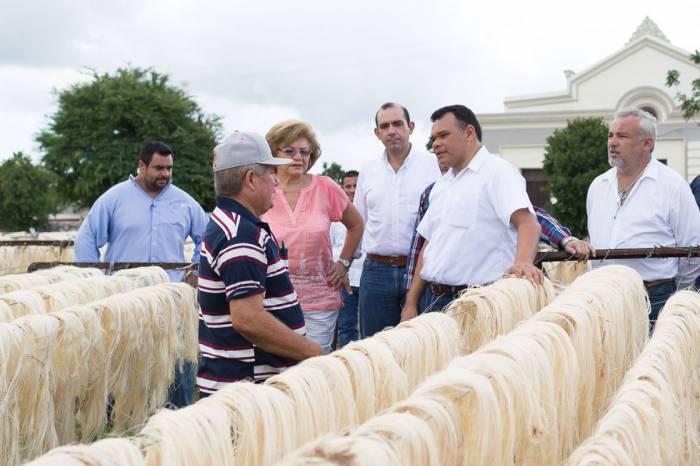It was in the early nineteenth century when the beginning of greater height of the sisal industry took place in Yucatan. Factories were established in large plantations (haciendas) and sisal products began to be exported all over the world.
By 1880, Yucatan was one of the most wealthy states in Mexico.
Sisal helped Yucatecan landowners to amass great fortunes, so it was called “green gold” because back then, Yucatán produced 90% of the ropes and bags used worldwide.
However, the value of sisal declined with the advent of synthetic fibers during World War I, and it never recovered.
In addition, the introduction of the “henequén” plant in Brazil, Madagascar, Tanzania and the Philippines (the plant was taken to those countries from Yucatán), contributed to the overall decline of this industry in the peninsula.
2016: eco-textile and preference for natural fibers rather than synthetic
Because the global market is increasingly demanding natural fiber to pack and wrap organic products, sisal industry could reborn in the Yucatan!
“The American, European, Chinese and Japanese markets do not want plastic anymore, in some countries the use of natural fiber to wrap or pack organic products is mandatory, and the number one natural fiber is “henequén” (sisal).
That means producing sisal could turn into a be a big business once again in the XXI century, and the Yucatan has to take advantage of this situation.
United States farmers and producers want natural fiber to tie the cattle feed, they don’t want to use plastic anymore. Coffee of the highest quality in Colombia is packed only in sisal sacks; and these are just two examples.
On the other hand, many of the current trends in interior decoration are also focusing on the use of natural materials and sisal (eco-textiles) tops the list of these materials for carpets, rugs, screens, ornaments, etc.
The residue is ideal to produce ethanol biofuel
Ethanol is one of the most important biofuels produced, at competitive prices, from renewable substrates such as sugar cane in Brazil or corn in the United States.
Because the current world production is insufficient to meet energy demand, they have developed other biotechnological processes that use agricultural and forestry residues, rich in cellulose and lignin, as substrates for the production of ethanol.
Currently in the Yucatan technologies are developed to use the juice, agro-product of fiber sisal (Agave fourcroydes Lem.). For example, in 2005, 250 million leaves of sisal were processed to produce 5000 tons of fiber, and this process left 75 million liters (20 million gallons) of juice as waste. This substrate contains a high percentage of oligofructans that can be easily used in the production of bioethanol; which means that this waste can be turned into millions of gallons of biofuel.
Bioethanol is easy to produce and store, and most important it is much less harmful for the environment.
In fact, on August 2015, the state government announced an investment of 13.6 billion pesos to increase the sowing area and increase sisal fiber production.
Governor Rolando Zapata Bello delivered the economic resources to 680 farmers in 34 different municipalities dedicated to the production of sisal.
Sources:



